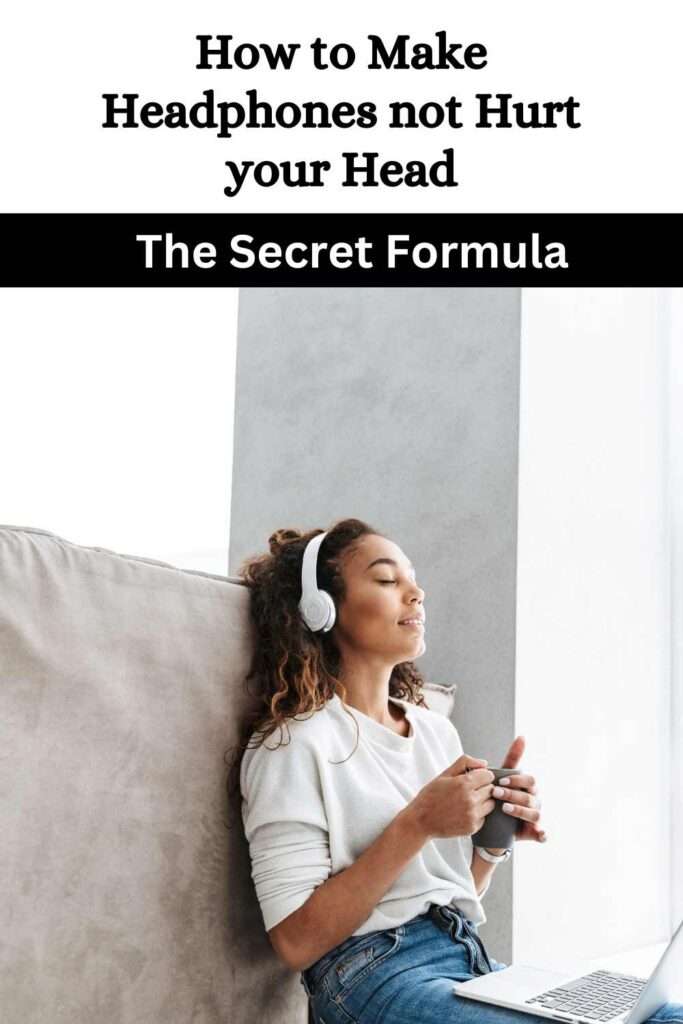Are you sick and tired of experiencing nausea or even pain after long periods of listening to music with headphones on? This is a common issue, but it does not have to be an ongoing problem.
If you’re looking for ways to make wearing headphones less uncomfortable for your head, you’ve come to the right place.
In this article, we will go over some helpful hints and pointers for choosing the right headphones, adjusting them correctly, taking breaks, utilizing ear pads or cushions, and keeping good posture.
You will be able to finish reading this article with the knowledge necessary to listen to music and podcasts without experiencing any kind of discomfort or pain. So, let’s get started!
In this Topic we will cover:-
- Choose the Right Headphones
- Adjust Headphones Properly
- Take Breaks
- Use Ear Pads or Cushions
- Maintain Good Posture
Tips on How to Make Headphones Comfortable
1. Choose the Right Headphones
Finding the right pair of headphones is the first and most important step in the process of avoiding headphone discomfort. There are several different types of headphones available, some of which include over-the-ear, on-the-ear, and in-ear models.
Over-ear headphones are by far the most common and extensive variety of headphones available. They have large ear cups that wrap around your ears completely and a headband that is padded and sits on top of your head.
These headphones completely enclose your ears. The most comfortable headphones are those that disperse the weight of the headphones across the entire head in an even manner and do not place any pressure on the ears.
On-ear headphones, on the other hand, have more compact ear cups that are designed to sit directly on the wearer’s ears. Because they put pressure on your ears and have the potential to become uncomfortable over time, they are a less comfortable alternative to over-ear headphones.
On the other hand, they are typically more compact and portable than headphones that cover the entire ear.
The smallest kind of headphones are in-ear headphones, which are also sometimes referred to as earbuds. They are worn directly in the ear canal and do not have a headband or ear cups of any kind.
In-ear headphones are the type of headphones that are the most portable and convenient, but the pressure that they place on the ear canal can cause discomfort after prolonged use.
When shopping for headphones, it is imperative to place a high priority on the comfort features they offer. Think about getting headphones that have a padded headband, comfortable ear cups or earbuds, an adjustable fit, and a weight that is manageable even after long periods of use.
Additionally, there are headphones available with ergonomic designs, which help to reduce the risk of experiencing discomfort.
2. Adjust Headphones Properly
The next step in preventing discomfort caused by headphones is to ensure that they are properly adjusted after you have chosen a pair of headphones that are appropriate for your needs.
If you take the time to properly adjust your headphones, you can make sure that they are comfortable and do not cause your head or ears any unnecessary strain.
First things first, check to see that your headphones are securely fastened to your head in the appropriate manner. While on-ear headphones should be able to rest comfortably on the ear, over-ear headphones should be able to fit over the ears without exerting any pressure.
The ear canal should be completely enclosed by in-ear headphones, but wearing them shouldn’t be painful or uncomfortable.
Make sure that your headphones have a comfortable fit by adjusting the headband. The weight of the headphones should be distributed evenly across your head by the headband, which should rest lightly on top of your head.
When wearing your headband, try to avoid wearing it too tightly or too loosely because either of these can eventually lead to discomfort.
Another issue that should be avoided is tight clamping, which takes place when the ear cups of over-ear headphones press against the head in an excessively close proximity. Pain in the ear, headaches, and other discomfort can be the result of prolonged, tight clamping.
If the fit of your headphones is too restrictive, you can try adjusting the headband to release some of the pressure that is being placed on your ears, or you can add ear cup cushions for even more comfort.
Before you begin using your headphones, you should make sure that they are properly adjusted and that they fit comfortably on your head. This will help to reduce the likelihood of experiencing any discomfort or pain.
3. Take Breaks
Taking breaks is absolutely necessary to avoid any discomfort or pain caused by wearing headphones.
While wearing headphones for extended periods of time to listen to music or other audio can cause fatigue and discomfort in the ears, head, and neck, the activity itself does not cause these symptoms.
It is critical to take frequent breaks while wearing headphones to prevent this from happening.
A good rule of thumb is to take a short break every hour at around the same time. During your break, remove your headphones and spend some time stretching your neck and shoulders, resting your ears, and moving your body.
If you are experiencing discomfort or fatigue, taking a short walk or engaging in some light physical activity may be beneficial.
You also have the option of lowering the volume on your headphones or switching to speakers for the time being.
It may be as simple as turning down the volume to relieve the strain on your ears and avoid discomfort. When you use speakers instead of headphones, you relieve your ears of the constant, direct pressure that headphones apply.
When working or studying while wearing headphones, it is especially important to take regular breaks. When one is preoccupied with a task, it is easy to forget to take breaks.
Taking frequent breaks, on the other hand, can improve productivity and concentration by lowering the worker’s fatigue and discomfort.
Taking frequent breaks is critical to avoiding discomfort and pain caused by headphones. Taking frequent breaks can help prevent fatigue and discomfort in your ears, head, and neck, as well as improve your overall listening experience.
4. Use Ear Pads or Cushions
Another method that can be used to alleviate the discomfort and pain caused by headphones is to use ear pads or cushions.
Ear pads and cushions are designed to relieve discomfort caused by pressure and pressure points in the ear canal by adding an extra layer of padding and support.
Over-ear headphones’ ear pads are the parts of the headphones that make contact with the wearer’s ears. The ear cushions may become worn out or compressed over time, reducing their ability to provide adequate cushioning.
If the ear cushions in your headphones appear worn, you should consider replacing them. Many headphone manufacturers provide customers with the option of purchasing replacement ear pads designed specifically for their products.
On-ear headphones frequently include ear cushions. Their function is to provide additional cushioning between the headphones and the wearer’s ears. Check that the earpads on the headphones are in the proper position and that they fit your ears comfortably.
In-ear headphones typically include silicone or foam ear tips that are designed to fit snugly within the ear canal. If the ear tips are causing you problems, you might want to try a different material or a larger size.
In-ear headphones come with a variety of ear tips in various sizes to fit a wide range of ear canals.
It may also be beneficial to add extra padding to your headphones to improve their comfort.
If the ear pads of your over-ear headphones continue to be uncomfortable for you, you may want to consider adding an additional layer of padding beneath the ear pads. To achieve this effect, foam padding or even a plush cloth can be used.
Overall, using ear cushions or pads to add padding and support to your ears can help prevent the discomfort and pain that headphones can cause.
These cushions and pads are available individually or as a set. Check that your headphones have the proper amount of padding and are of the appropriate type. Replace any ear pads that have become worn if necessary.
5. Maintain Good Posture
Good posture is another way to avoid discomfort and pain while listening to music with headphones. The discomfort caused by headphones can be exacerbated by poor posture, which can cause tension and strain in the neck, shoulders, and upper back.
Maintain good posture by sitting up straight and lowering and retracting your shoulders. Maintaining a neutral head position is preferable to leaning forward or to one side.
Always use your computer or mobile device while wearing headphones at eye level to avoid neck strain.
Additionally, you must take frequent breaks, stretch, and maintain good posture. Stretching can alleviate tension in the neck, shoulders, and upper back caused by prolonged headphones use.
Consider regularly removing your over-ear headphones to give your ears and head a break. You could also try repositioning the headphones to alleviate some of the strain on your head and ears.
Long-term, maintaining correct posture can be beneficial to one’s health and well-being, as well as reduce the likelihood of discomfort and pain.
Good posture, which promotes correct alignment and reduces strain on the body, can improve circulation, muscle tension, and even breathing.
Conclusion
Finally, using headphones to listen to music, podcasts, audiobooks, and other forms of audio content is a common and practical practice. However, if not used properly, it can cause a lot of discomfort and even pain.
To avoid discomfort and pain while wearing headphones, it is critical to choose the correct headphones, adjust them properly, take breaks, use ear pads or cushions, and maintain good posture.
When shopping for headphones, it is critical to consider a number of factors such as fit, comfort, sound quality, and style. Headphones must be placed correctly on the head and over the ears in order to be adjusted properly.
During breaks, move around, stretch, and remove your ears and head from the direct pressure of the headphones. Cushions and pads designed specifically for the ears can add an extra layer of padding and support.
Maintaining proper posture can help relieve strain on your neck and upper back while also improving the overall quality of your listening experience.
Frequently asked questions
How do I know if my headphones are too tight?
If your headphones are too tight, you may experience discomfort or pain around your ears, on top of your head, or in your neck and shoulders. The headphones may also leave indentations or marks on the skin. To avoid discomfort and pain, ensure that your headphones are properly adjusted and select a pair that fits comfortably.
How can I prevent headphone-related pain and discomfort?
To avoid headphone-related pain and discomfort, it is important to select the proper headphones, adjust them appropriately, take frequent breaks, use ear pads or cushions, and maintain good posture while wearing headphones. By following these instructions, you may find that your ears, head, and neck experience less strain, pressure, and discomfort.

